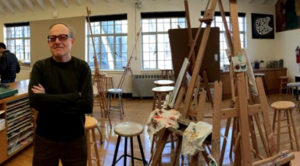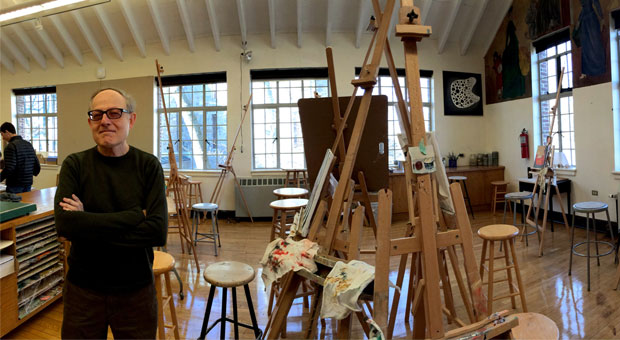
After over three decades at Fieldston, Richard Rudich has announced his plans to retire from the Visual Arts Department at the end of this year. Mr. Rudich, who began in 1983 as a temporary replacement, has been instrumental in the development of the school’s architecture program, mapping a curriculum that begins in seventh grade, and continues straight through senior year.
In a letter to the Fieldston community, Rudich provided insight into the timing of his decision. “This has been one of my happiest and most engaging years at Fieldston,” he said, “and it seems a perfect time, if there is such a time, to undertake some new challenges outside [of school].” Mark Stracke, Chair of the Visual Arts Department, said that Rudich’s “extensive and various experience, wisdom, dedication to teaching, and generosity with adults and students alike” are what made him such a special part of the department and the school as a whole.
Earlier this month on Founder’s Day, Rudich received a lengthy standing ovation from the students and faculty in attendance. Head of School Dr. Damian Fernandez acknowledged Mr. Rudich’s contributions to the Fieldston community. “He is a gentleman, a scholar, and a craftsman,” said Dr. Fernandez. “He has helped students to craft lives of their own. Richard, we can’t wait to see what you do in this next phase of your life.”
Growing up, Mr. Rudich lived in Upper Manhattan, near Fort Tryon Park. “The Cloisters had a great impact on my imagination and aesthetic sensibility and remain my favorite museum in New York,” he said. “[They] helped make me an artist and a gardener, a quiet observer of the marvels of human invention.”
But Mr. Rudich didn’t always think of himself as a man of the arts. In high school, the now art teacher had his eye on math and science. However, his studies at Columbia University gave Rudich a look into the various architectural styles and techniques of civilizations past. He was hooked. “There were no studio arts offered at that time [at Columbia],” said Mr. Rudich, “but I started to think of architecture as my professional destination.”
After college, Mr. Rudich traveled to Italy and Egypt for a year, then returned to Columbia for Architecture school. Mr. Rudich continued to cultivate his interest in studio arts. Toward the end of his Architecture school career, he developed a passion for ceramic sculpture, and eventually went back to school to earn an MFA in ceramics and painting.
By the 1980’s, Mr. Rudich had shows in New York, Chicago, London, and the Hamptons. His work began to circulate through the art world, leading to The Metropolitan Museum of Art’s purchase of an assortment of pieces from his very first show. Then, as Mr. Rudich puts it, “along came Fieldston.”
Mr. Rudich credits most of his tenure at Fieldston to pure chance. “Much that happens in life is accidental and one must pay attention to the unexpected,” he explains. “I did not intend to fall in love when I first came to Fieldston, nor did I intend to stay for thirty years. I started as a one-semester replacement in the art department in 1983. It was very challenging, exhausting work teaching a variety of arts, from metal sculpture to printmaking and painting and drawing.”
Perhaps the challenge of learning how to connect with his students on a personal level was even more strenuous for Mr. Rudich than teaching the arts themselves. “I had ambitious ideas but not yet the language to communicate with my audience,” he says. “I used to joke with my students that I came from Nis [in Serbia]. This was to explain any difficulties I had speaking with and listening to teenagers.”
To Mr. Rudich’s surprise, the person he was filling in for decided not to return and Fieldston offered him a permanent job. He accepted the position and continued to teach a wide range of classes including woodworking and architectural drawing. But, to his dismay, a few years later the woodworking program was eliminated from the Fieldston course of studies. Mr. Rudich “felt urgency about replacing it with classes that would somehow engage and encourage similar skills in design and craftsmanship,” so he used the theme of architecture “to build a new program that [would grow] steadily over the years” in all divisions at school. Mr. Rudich achieved his goal; his passion for handworked art (“We know the world through our hands as much as through our eyes,” he claims) helped fuel the development of Fieldston’s renowned visual arts department.
As one might expect, Mr. Rudich isn’t leaving the same Fieldston he encountered over three decades ago. Sadly, he says, “Fieldston was more quirky and original thirty years ago. It did not have all the corporate aspects, all the outsourcing that we have today.” Mr. Rudich also seems worried about the character of the school. “It was much smaller and more self-sufficient [when I arrived at Fieldston]. The middle and upper schools shared a campus and there was a certain artful edginess to life [here].”
As for the development of the art facilities during his time at Fieldston, Mr. Rudich says things “have changed quite a bit over the years” and that “studios have changed function or been renovated. The architecture room was quite a dump and had a lovely rehab about twelve years ago,” he recalls.
Mr. Rudich takes pride in students of his who have gone on to work in the fields of architecture, industrial design, art history, and more. Among his most successful protégés include a graffiti painter in Spain and a teacher at the Neue Bauhaus in Germany. As Mr. Rudich puts it, “some [of these students] were very strong [academically]. Some struggled in every way but were brilliant with their hands and imagination and did very well after Fieldston.”
The soon-to-be retiree says he will miss many things about Fieldston, but he has a special place in his heart for the secretarial staff at school. The people in the office “[have] always been the best: enormously competent and supportive, very cheerful and unflappable. They have helped me get through every mistake and misstep and never ratted on me,” he says. In the end, though, Rudich has cherished interactions with his trainees more than anything else. “The conversation with my students…is without a doubt what I will miss the most,” he explains. “It has been sustaining and enriching, seriously inappropriate sometimes, incomprehensible, and instructive.”
So why leave now? “I am perfectly happy at Fieldston,” Mr. Rudich says, “but after thirty years it is time for a change and new challenges. I hope to spend more time in my studio than has been possible these last few years.” Mr. Rudich also hopes to designate some of his free time to travel. “There is much of the world that I still haven’t seen,” he remarks. “Uruguay comes to mind. And Asia.”
We will forever remember Mr. Rudich for his contributions as an educator and innovator within the arts department and throughout the Fieldston community. His retirement marks the end of an era. But for someone who seems to have had such a lasting and wide-ranging impact on our institution, Mr. Rudich’s approach to teaching is surprisingly straightforward. “My objective [has been] to get students to look at the built world and to question what they [see]. And I wanted to give them some experience of the architectural imagination through accessible projects that involved deceptively simple ideas and challenging craftsmanship.”
Like his education strategy, Mr. Rudich kept his parting words for the Fieldston community short: “¡Hasta pronto! I’ll be back!”
Fieldston thanks you, Mr. Rudich, and we look forward to following your future endeavors.






